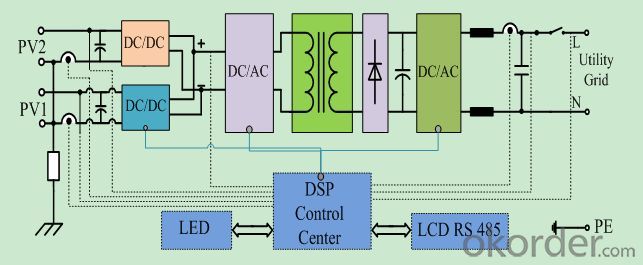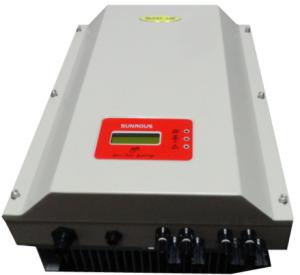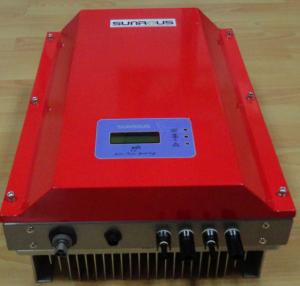Grid-Tied Inverter Dual MPPT Easy to Install and Operate
- Loading Port:
- Shanghai
- Payment Terms:
- TT or LC
- Min Order Qty:
- 100 mm
- Supply Capability:
- 2000 mm/month
OKorder Service Pledge
OKorder Financial Service
You Might Also Like
·High frequency transformer isolation and conversion efficiency rate up to 97%.
·Dual input sections with independent MPP tracking, allows optimal energy harvesting from two sub-arrays oriented in different directions · High speed and precise MPPT algorithm for real time power tracking and improved energy harvesting, as well as regular MPP Adaptation Efficiency of over 99.0%. ·Flat efficiency curves ensure high efficiency at all output levels ensuring consistent and stable performance across the entire input voltage and output power range ·Wide input DC MPPT range(150V~550V)/output AC voltage range (180V~264V) ·IP 65/NEMA 3R, outdoor enclosure for unrestricted use under any environmental conditions ·Any modules can be used and fit in this device whether crystalline or thin-film. ·Use in residential applications requiring PV array plug-in grounding. ·RS-485 communication interface (designed for connection to computer or data-logger) ·Easy to install and operate with reduced weight.
GT3.6-ZX-01/HF | |
Input(DC) | |
Max.DC Power | 3800W |
Max.DC Voltage | 500V |
PV Voltage range, MPPT | 60V ~ 360V |
Max.input current | 30.0A |
Number of MPP trackers | 2 |
Max.number of strings (parallel) | 4 |
Output(AC) | |
Nominal AC power / | 3600W/3600W |
Max.output current | 16.0A |
Nominal AC Voltage / range | 180V~264V |
AC grid frequency / range | 47.5-51.5Hz / 59.3-60.5Hz |
Power factor at rated power | 1 |
THD | < 3% |
AC connection | Single-phase |
Efficiency | |
Max. efficiency/Californian efficiency | > 98.0% / > 97.0% |
MPP adaptation efficiency | > 99.0% |
Protection devices | |
DC reverse polarity protection | √ |
AC short-circuit protection | √ |
Ground fault monitoring | √ |
Grid monitoring | √ |
Output Transient Voltage Suppression | √ |
Over load | √ |
Anti-islanding | √ |
General data | |
Dimensions (W/ H / D) in mm | 370 / 540 / 185 mm |
Weight | 23kg |
Operating temperature range | -25 ~ +60℃ |
Storage temperature range | -40 ~ +70℃ |
Ambient humidity | 0 ~ 100% |
Consumption (night) | < 0.5W |
Topology | HF-transformer galvanic isolation |
Cooling concept | Convection |
Enclosure type | IP65 / NEMA 3R |
Features | |
DC connection: PV special connector | √ |
AC connection: connector | √ |
LCD display & Backlit | √ |
LED display | √ |
Interfaces: RS485 | √ |
Warranty: 10 years | √ |
Certificates & approvals | G83 / G59 / TUV / SAA / ETL / JET/ CE |
Our inventers support most of mainstream components and modules in the market. Should you require more details, please do not hesitate to contact our technical personnel.
FAQ
What kinds of modules do your inventers support?
They can be used in the small photovoltaic (PV) grid power generation systems of family units as well as the commercial photovoltaic system such as BIPV, BAPV and etc.
What is the application field of your products?
Contact details can be found from website www.okorder.com to contact us. We look forward to providing you with professional services.
How to contact us?
You could find our products from dealers or contact our sales team directly. We will provide you with detailed services.
Where can I buy your products?
5. Any problems, the company will provide solutions for users within 48 hours.
4. Regularly listen to opinions and suggestions of users, to provide users with new trends in technological innovation, new product information and enhance mutual understanding.
3. The long-term tracking service system: we practice lifelong quality of our product tracking service, and we also will take effective measures and solutions for the user of the technical issues and equipment problems.
2. The company is responsible for professional users’ on-site operator training and technical exchange.
1. During the equipment commissioning period, the company will send scheduler to commissioning to ensure debugging smoothly and a one-time test commissioning.
After-sales Services Undertakings

High frequency transformer isolation is the main feature of our production, which makes Installation easier due to the reduced weight and higher conversion effciency because of omitting Low frequency transformer. The wide input voltage range from 180 to 600voltage gives you extraordinary fexibility for you system design. Not need to set graphic display and RS485 communication system make the devices highly user-friendly.
This product can by multi-level parallel combination for 6kw to 20kw needed any power grade HF series technical parameter.
- Q:What are the methods of photovoltaic grid-connected inverter control
- and can set the dead time between the upper and lower arms, the use of INTEL 80C196MC to achieve sine wave output circuit, 80C196MC to complete the sine wave signal, AC output voltage, to achieve regulation. Circuit output generally use LC circuit filter high frequency wave, get pure sine wave.
- Q:Is the PV inverter a current source or a voltage source?
- Inverter is a kind of semiconductor device composed of power adjustment device, mainly used for DC power into AC power.
- Q:Are there any government incentives for installing solar inverters?
- Yes, there are government incentives available for installing solar inverters. These incentives vary by country and region, but they often include tax credits, grants, or rebates to encourage the adoption of solar energy. Additionally, some governments may offer net metering programs, which allow homeowners to sell excess electricity generated by their solar inverters back to the grid. It is important to research the specific incentives available in your area to take full advantage of the benefits.
- Q:What are the different types of solar inverters available?
- There are several types of solar inverters available, including string inverters, microinverters, and power optimizers. String inverters are the most common and are installed at a central location, converting the DC power generated by multiple solar panels into AC power. Microinverters, on the other hand, are installed on each individual solar panel, converting the DC power to AC power at the panel level. Power optimizers are similar to microinverters but work in conjunction with a string inverter, optimizing the power output of each panel before it reaches the inverter. Each type of inverter has its own advantages and suitability based on the specific solar installation requirements.
- Q:What is the maximum efficiency rating of a solar inverter?
- The maximum efficiency rating of a solar inverter can vary depending on the model and manufacturer, but typically it ranges from 95% to 98%.
- Q:How does a solar inverter handle anti-islanding protection?
- A solar inverter handles anti-islanding protection by constantly monitoring the grid voltage. If the grid goes down or voltage drops below a certain threshold, the inverter automatically disconnects from the grid to prevent feeding power back into the grid during an outage. This ensures the safety of utility workers and prevents damage to the grid.
- Q:Can a solar inverter be used with different types of solar tracking systems?
- Yes, a solar inverter can be used with different types of solar tracking systems. The solar inverter is responsible for converting the direct current (DC) generated by the solar panels into alternating current (AC) that can be used to power household appliances or be fed back into the grid. The type of solar tracking system, whether it is a single-axis or dual-axis tracker, does not affect the compatibility of the solar inverter. As long as the solar inverter is appropriately sized and compatible with the solar panels, it can be used with any type of solar tracking system.
- Q:What is the role of a solar inverter in a net metering system?
- The role of a solar inverter in a net metering system is to convert the direct current (DC) electricity generated by solar panels into alternating current (AC) electricity that can be used by the grid or consumed in the building. It also ensures that any excess electricity produced by the solar panels is fed back into the grid, allowing the system owner to receive credits or compensation for the surplus energy.
- Q:How does shade affect the performance of a solar inverter?
- Shade has a significant impact on the performance of a solar inverter. When a solar panel is partially shaded, it reduces the amount of sunlight reaching the panel, resulting in a decrease in power generation. This leads to a decrease in the overall performance of the solar system, as the inverter's efficiency is directly linked to the amount of power it receives from the panels. Additionally, shade can also cause voltage fluctuations and imbalances, potentially damaging the inverter. Therefore, avoiding shade and ensuring unobstructed sunlight is crucial for optimal performance of a solar inverter.
- Q:What is the role of an isolation transformer in a solar inverter?
- The role of an isolation transformer in a solar inverter is to provide electrical isolation and safety. It separates the input and output circuits, preventing any direct electrical connection between them. This isolation helps protect the inverter and its connected devices from electrical faults, such as ground faults, and reduces the risk of electric shock. Additionally, the isolation transformer can also help reduce common mode noise and provide better power quality by reducing the effects of electromagnetic interference.
1. Manufacturer Overview |
|
|---|---|
| Location | |
| Year Established | |
| Annual Output Value | |
| Main Markets | |
| Company Certifications | |
2. Manufacturer Certificates |
|
|---|---|
| a) Certification Name | |
| Range | |
| Reference | |
| Validity Period | |
3. Manufacturer Capability |
|
|---|---|
| a)Trade Capacity | |
| Nearest Port | |
| Export Percentage | |
| No.of Employees in Trade Department | |
| Language Spoken: | |
| b)Factory Information | |
| Factory Size: | |
| No. of Production Lines | |
| Contract Manufacturing | |
| Product Price Range | |
Send your message to us
Grid-Tied Inverter Dual MPPT Easy to Install and Operate
- Loading Port:
- Shanghai
- Payment Terms:
- TT or LC
- Min Order Qty:
- 100 mm
- Supply Capability:
- 2000 mm/month
OKorder Service Pledge
OKorder Financial Service
Similar products
New products
Hot products
Hot Searches
Related keywords































